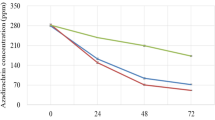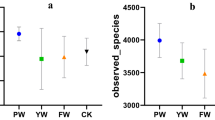Abstract
Intensive agriculture has resulted in an indiscriminate use of pesticides, which demands in-depth analysis of their impact on indigenous rhizospheric microbial community structure and function. Hence, the objective of the present work was to study the impact of two chemical pesticides (chlorpyrifos and cypermethrin) and one biological pesticide (azadirachtin) at two dosages on the microbial community structure using cultivation-dependent approach and on rhizospheric bacterial communities involved in nitrogen cycle in Vigna radiata rhizosphere through cultivation-independent technique of real-time PCR. Cultivation-dependent study highlighted the adverse effects of both chemical pesticide and biopesticide on rhizospheric bacterial and fungal communities at different plant growth stages. Also, an adverse effect on number of genes and transcripts of nifH (nitrogen fixation); amoA (nitrification); and narG, nirK, and nirS (denitrification) was observed. The results from the present study highlighted two points, firstly that nontarget effects of pesticides are significantly detrimental to soil microflora, and despite being of biological origin, azadirachtin exerted negative impact on rhizospheric microbial community of V. radiata behaving similar to chemical pesticides. Hence, such nontarget effects of chemical pesticide and biopesticide in plants’ rhizosphere, which bring out the larger picture in terms of their ecotoxicological effect, demand a proper risk assessment before application of pesticides as agricultural amendments.




Similar content being viewed by others
References
Abdul-Baki AA (1974) Pitfalls in using sodium hypochlorite as a seed disinfectant in 14C incorporation studies. Plant Physiol 53:768–771
Abhilash PC, Singh N (2009) Pesticide use and application: an Indian scenario. J Hazard Mater 165:1–12
Ahmed S, Ahmad MS (2006) Effect of insecticides on the total number of soil bacteria under laboratory and field conditions. Pak Entomol 28:63–68
Aislabie J, Lloyd-Jones G (1995) Bacterial degradation of pesticides. Aust J Soil Res 33:925–942
Anderson A, Baldock JA, Rogers SL et al (2004) Influence of chlorsulfuron on rhizobial growth, nodule formation, and nitrogen fixation with chickpea. Aust J Agric Res 55:1059–1070
Atterby H, Smith N, Chaudhry Q, Stead D (2002) Exploiting microbes and plants to clean up pesticide contaminated environments. Pestic Outlook 13:9–13
Bending GD, Lincoln SD, Edmondson RN (2006) Spatial variation in the degradation rate of the pesticides isoproturon, azoxystrobin and diflufenican in soil and its relationship with chemical and microbial properties. Environ Pollut 139:279–287
Bru D, Sarr A, Philippot L (2007) Relative abundances of proteobacterial membrane-bound and periplasmic nitrate reductases in selected environments. Appl Environ Microbiol 73:5971–5974
Bünemann EK, Schwenke GD, Van Zwieten L (2006) Impact of agricultural inputs on soil organisms—a review. Aust J Soil Res 44:379–406
Chen LZ, Li YL, Yu YL (2014) Soil bacterial and fungal community successions under the stress of chlorpyrifos application and molecular characterization of chlorpyrifos-degrading isolates using ERIC-PCR. J Zhejiang Univ Sci B 15:322–332
Chu XQ, Fang H, Pan XD, Wang X, Shan M, Feng B, Yu YL (2008) Degradation of chlorpyrifos alone and in combination with chlorothalonil and their effects on soil microbial populations. J Environ Sci 20:464–469
Coventry E, Allan EJ (2002) Microbiological and chemical analysis of neem (Azadirachta indica) extracts: new data on antimicrobial activity. Phytoparasitica 49:441–450
Dahlin S, Witter E (1998) Can the low microbial biomass C-to-organic C ratio in an acid and a metal contaminated soil be explained by differences in the substrate utilization efficiency and maintenance requirements? Soil Biol Biochem 30:633–641
Datta A, Sindel BM, Kristiansen P (2009) Effect of isoxaflutole on the growth, nodulation and nitrogen fixation of chickpea (Cicer arietinum L.). Crop Prot 28:923–927
Dubus I, Hollis J, Brown C (2000) Pesticides in rainfall in Europe. Environ Pollut 110:331–344
Edvantoro BB, Naidu R, Megharaj M, Singleton I (2003) Changes in microbial properties associated with long-term arsenic and DDT contaminated soils at disused cattle dip sites. Ecotoxicol Environ Saf 55:344–351
Elnasikh MH, Osman AG, Sherif AM (2011) Impact of neem seed cake on soil microflora and some soil properties. J Sci Technol 12:144–150
Fox JE, Gulledge J, Engelhaupt E (2007) Pesticides reduce symbiotic efficiency of nitrogen-fixing rhizobia and host plants. Proc Natl Acad Sci U S A 104:10282–10287
Gilani STS, Ageen M, Shah H, Raza S (2010) Chlorpyrifos degradation in soil and its effect on soil microorganisms. J Anim Plant Sci 20:99–102
Gopal M, Gupta A, Arunachalam V, Magu SP (2007) Impact of azadirachtin, an insecticidal allelochemical from neem on soil microflora, enzyme and respiratory activities. Bioresour Technol 98:3154–3158
Goswami M, Pati U, Chowdhury A, Mukhopadhyay A (2012) Studies on the effect of cypermethrin on soil microbial biomass and its activity in an alluvial soil. Int J Agric Food Sci 3:1–9
Gupta S, Gupta R, Sharma S (2013) Impact of chemical- and bio-pesticides on bacterial diversity in rhizosphere of Vigna radiata. Ecotoxicology 22:1479–1489. doi:10.1007/s10646-013-1134-1
Henry S, Baudoin E, López-Gutiérrez JC (2004) Quantification of denitrifying bacteria in soils by nirK gene targeted real-time PCR. J Microbiol Methods 59:327–335
Hout MC, Papesh MH, Goldinger SD (2013) Multidimensional scaling. Wiley Interdiscip Rev Cogn Sci 4:93–103
Ibekwe AM, Papiernik SK, Grieve CM, Yang C-H (2010) Influence of fumigants on soil microbial diversity and survival of E. coli O157:H7. J Environ Sci Health B 45:416–426
Imfeld G, Vuilleumier S (2012) Measuring the effects of pesticides on bacterial communities in soil: a critical review. Eur J Soil Biol 49:22–30
Iqbal Z (2002) Impact of long- term agrochemical usage on microbial and enzymatic activities in soils. Dissertation, University of the Punjab
Jose AI (2002) Package of practices recommendations: crops. Directorate of extension, Kerala Agricultural University Thrissur, Kerala
Kandeler E, Deiglmayr K, Tscherko D (2006) Abundance of narG, nirS, nirK, and nosZ genes of denitrifying bacteria during primary successions of a glacier foreland. Appl Environ Microbiol 72:5957–5962
Killham K, Staddon WJ (2002) Bioindicators and sensors of soil health and the application of geostatistics. In: Burns RG, Richard D (eds) Enzymes in the environment: activity, ecology, and applications. Marcel Dekker, New York, pp 391–405
Laursen AE, Carlton RG (1999) Responses to atrazine of respiration, nitrification, and denitrification in stream sediments measured with oxygen and nitrate microelectrodes. FEMS Microbiol Ecol 29:229–240
Leininger S, Urich T, Schloter M (2006) Archaea predominate among ammonia-oxidizing prokaryotes in soils. Nature 442:806–809
Li X, Jiang J, Gu L (2008) Diversity of chlorpyrifos-degrading bacteria isolated from chlorpyrifos-contaminated samples. Int Biodeterior Biodegrad 62:331–335
Little TM and Hills FJ (1978) Agricultural experimentation design and analysis. John Wiley and Sons, Inc, New York
Mallik MAB, Tesfai K (1985) Pesticidal effect on soybean-rhizobia symbiosis. Plant Soil 41:33–41
Martinez-Toledo MV, Salmeron V, Gonzalez-Lopez J (1992) Effect of the insecticides methylpyrimifos and chlorpyrifos on soil microflora in an agricultural loam. Plant Soil 147:25–30
McCarty GW (1999) Modes of action of nitrification inhibitors. Biol Fertil Soils 29:1–9
Monkiedje A, Olusoji M, Spiteller M (2002) Soil quality changes resulting from the application of the fungicides mefenoxam and metalaxyl to a sandy loam soil. Soil Biol Biochem 34:1939–1948
Montes-Molina JA, Luna-Guido M, Ceballos-Ramirez JM (2008) Effect of pest-controlling neem and mata-raton on bean growth, soil N and soil CO2 emissions. Agron Sustain Dev 28:187–194
Pandey S, Singh DK (2004) Total bacterial and fungal population after chlorpyrifos and quinalphos treatments in groundnut (Arachis hypogaea L.) soil. Chemosphere 55:197–205
Pimentel D (1995) Amounts of pesticides reaching target pests: environmental impacts and ethics. J Agric Environ Ethics 8:17–29
Poly F, Monrozier LJ, Bally R (2001) Improvement in the RFLP procedure for studying the diversity of nifH genes in communities of nitrogen fixers in soil. Res Microbiol 152:95–103
Rousidou C, Papadopoulou ES, Kortsinidou M (2013) Bio-pesticides: harmful or harmless to ammonia oxidizing microorganisms? The case of a Paecilomyces lilacinus-based nematicide. Soil Biol Biochem 67:98–105
Rousk J, Brookes PC, Bååth E (2009) Contrasting soil pH effects on fungal and bacterial growth suggest functional redundancy in carbon mineralization. Appl Environ Microbiol 75:1589–1596
Shan M, Fang H, Wang X (2006) Effect of chlorpyrifos on soil microbial populations and enzyme activities. J Environ Sci (China) 18:4–5
Sharma S, Mehta R, Gupta R, Schloter M (2012) Improved protocol for the extraction of bacterial mRNA from soils. J Microbiol Methods 91:62–64
Sigler WV, Turco RF (2002) The impact of chlorothalonil application on soil bacterial and fungal populations as assessed by denaturing gradient gel electrophoresis. Appl Soil Ecol 21:107–118
Singh BK, Walker A, Wright DJ (2002) Degradation of chlorpyrifos, fenamiphos, chlorothalonil alone and in combination and their effect on soil microbial activity. Environ Toxicol Chem 21:2600–2605
Singh S, Gupta R, Sharma S (2015) Effects of chemical and biological pesticides on plant growth parameters and rhizospheric bacterial community structure in Vigna radiata. J Hazard Mater 291:102–110. doi:10.1016/j.jhazmat.2015.02.053
Sivanesan SD, Krishnamurthi K, Wachasunder SD, Chakrabarti T (2004) Genotoxicity of pesticide waste contaminated soil and its leachate. Biomed Environ Sci 17:257–265
Spyrou IM, Karpouzas DG, Menkissoglu-Spiroudi U (2009) Do botanical pesticides alter the structure of the soil microbial community. Microb Ecol 58:715–727
Su ZC, Zhang HW, Li XY, Zhang Q, Zhang CG (2007) Toxic effects of acetochlor, methamidophos and their combination on nifH gene in soil. J Environ Sci (China) 19:864–873
Worrall F, Besien T (2005) The vulnerability of groundwater to pesticide contamination estimated directly from observations of presence or absence in wells. J Hydrol 303:92–107
Wu X, Xu J, Dong F (2014) Responses of soil microbial community to different concentration of fomesafen. J Hazard Mater 273:155–164
Yang Y-H, Yao J, Wang MC (2004) RAPD marker and substrate utilization pattern applied to study microbial community diversity in the soil affected by agricultural chemicals. J Environ Sci Health B 39:125–138
Yeomans JC, Bremner JM (1985) Denitrification in soil: effects of insecticides and fungicides. Soil Biol Biochem 17:435–456
Zhang B, Bai Z, Hoefel D (2009) The impacts of cypermethrin pesticide application on the non-target microbial community of the pepper plant phyllosphere. Sci Total Environ 407:1915–1922
Zhuang R, Chen H, Yao J, Li Z, Burnet JE, Choi MM (2011) Impact of beta-cypermethrin on soil microbial community associated with its bioavailability: a combined study by isothermal microcalorimetry and enzyme assay techniques. J Hazard Mater 189:323–328
Acknowledgments
The authors wish to thank the Science and Engineering Research Board (SERB), Department of Science and Technology, Government of India, for funding this project (SR/FT/LS-181/2009). Dr. Laurent Philippot’s (INRA, Dijon, France) kind help by providing the standard strains for qPCR is highly acknowledged.
Conflict of interest
The authors declare that there are no conflicts of interest.
Author information
Authors and Affiliations
Corresponding author
Additional information
Responsible editor: Robert Duran
Electronic supplementary material
Below is the link to the electronic supplementary material.
Online resource 1
Non-metric multidimensional scaling (NMS) to compare effects of different pesticide treatments on fungal community (a) nitrogen fixing bacteria (b) Pseudomonas spp. (c) and phosphate solubilizing bacteria (d). L low dose, H high dose, A azadirachtin, C chlorpyrifos, CY cypermethrin. (DOC 149 kb)
Online resource 2
Non-metric multidimensional scaling (NMS) to compare effects of different pesticide treatments on the abundance of nifH gene (a) and transcripts (b) at three different time points. For abbreviations please refer to legend for Online resource 1. (DOC 77 kb)
Online resource 3
Non-metric multidimensional scaling (NMS) to compare effects of different pesticide treatments on the abundance of amoA gene (a) and transcripts (b) at three different time points. For abbreviations please refer to legend for Online resource 1. (DOC 75 kb)
Online resource 4
Non-metric multidimensional scaling (NMS) to compare effects of different pesticide treatments on the abundance of narG gene (a) narG transcripts (b) nirK gene (c) nirK transcripts (b) nirS gene (a) and nirS transcripts (b) at three different time points. For abbreviations please refer to legend for Online resource 1. (DOC 174 kb)
Rights and permissions
About this article
Cite this article
Singh, S., Gupta, R., Kumari, M. et al. Nontarget effects of chemical pesticides and biological pesticide on rhizospheric microbial community structure and function in Vigna radiata . Environ Sci Pollut Res 22, 11290–11300 (2015). https://doi.org/10.1007/s11356-015-4341-x
Received:
Accepted:
Published:
Issue Date:
DOI: https://doi.org/10.1007/s11356-015-4341-x




